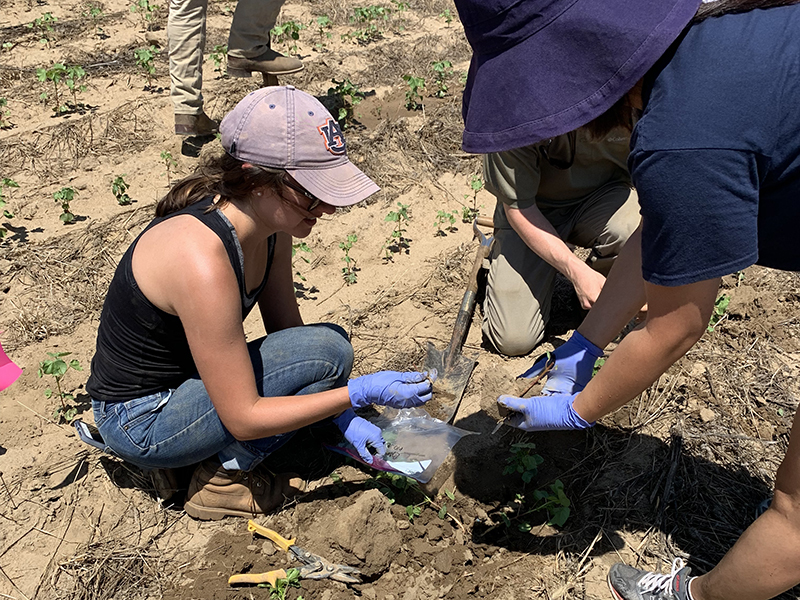
This item gives an excellent explanation of soil fungal synbiosis. All this was not well understood in the ecent past, which means that most soil managent programs outright wrong. Just what were we thinking when we used the plow?
We do not want to collapse this biome at all. We want to plant into it.
You know that general planting can be completely rethought. Imagine using a giant roll of newsprint which has been manufactured with preset seeds We could even add in a thin layer of plastic to seal the surface as well.
The surface is worked shallowly leaving a thin active layer of soil on top. The roll is then laid down under a little presure. then wetted after. For as long as the layer survives, weeds will be suppressed. A preliminary top dressing of fertilizer can also be applied if justified at all.
There is a fungus among us!
Arbuscular mycorrhizal fungi benefit crops in many ways
August 16, 2021 – Fungi play very important roles for plants and subsequently, humans. The Soil Science Society of America’s August 15th Soils Matter blog takes a look at how these “living fertilizers” can help the soil – and our crop production systems, too. This week’s blog is written by Hayley Crowell from North Carolina State University.
For over four hundred million years, arbuscular mycorrhizal fungi have been forming symbiotic relationships with plants around the globe. Found on almost every continent and in approximately 80% of vascular plants, these important fungi play a pivotal role in plant nutrient uptake in diverse ecosystems.
These important fungi begin their life in the soil – in the area where roots can grow. Plants release hormones that helps the fungi grow. The plants release the hormones to increase the chance of a root-fungi interaction.
Plants seek to interact with arbuscular mycorrhizal fungi to create a mutually beneficial relationship. Once the fungi and plant roots meet, the fungi penetrate the root cells. From there, the fungi create and establish incredible structures called arbuscules, which were named for their tree-like structure.
Due to their many branches, arbuscules have a high surface area. This allows the fungi to efficiently exchange many different nutrients with the plant. Arbuscular mycorrhizal fungi are known for increasing uptake of phosphorous in the plants they interact with. They can also provide greater uptake of nitrogen, potassium, zinc, and more.
In exchange, the host plant provides food to arbuscular mycorrhizal fungi. The plant shares products it makes during photosynthesis, like lipids and sugars. Arbuscular mycorrhizal fungi rely on the host plant for life, but it is a small price to pay for the plant to have greater access to essential nutrients.
Meanwhile, in the soil, arbuscular mycorrhizal fungi form an extensive network of hyphae. The branched hyphal system acts as an extension of the root system. This provides greater access to nutrients that would have otherwise been out of reach. This longer, extensive hyphal system can reach into soil pores that were previously too small for the root system to explore.
Although arbuscular mycorrhizal fungi are small, they are mighty! One gram of soil can contain between one to twenty meters of hyphae. The microscopic fungi can dramatically improve nutrient uptake for its host plant. It is incredible what these fungi do for plants and, subsequently, humans.
Many researchers are exploring arbuscular mycorrhizal fungi’s role in agriculture. Important crops around the world, such as wheat, rice, corn, potato, cotton, and soybean, can form relationships with them. Finding ways to use the fungi’s impressive abilities could enable producers to meet the growing demand for food in an environmentally friendly way.
Sometimes referred to as “living fertilizers,” arbuscular mycorrhizal fungi have the potential to maintain yield while reducing some need for fertilizer. These fungi boost nutrient and water uptake. They can enhance soil structure. They even have been shown to improve plant responses stresses, such as soil salinization, heavy metal contamination, and extreme temperatures.
With the known benefits, it's no surprise that researchers are looking to further understand how to protect and take advantage of these powerful, ancient fungi to improve crop productivity in degraded soils and a changing climate.
To read another blog about soil fungi, read Do plants and soil really talk. Be sure to subscribe to the Soils Matter blog to receive all our blogs.
Photo caption: Hayley Crowell, Anna Yang, and others carefully collect cotton root samples to analyze arbuscular mycorrhizal fungi colonization rates. Credit: Audrey Gamble
High-resolution images for use with this story only available here, or contact Susan Fisk, sfisk@sciencesocieties.org.
No comments:
Post a Comment